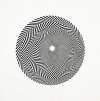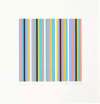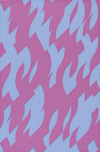Elongated
Triangles
Disorientating and stimulating, Bridget Riley’s Elongated Triangles (1971) explores the complex relationship between shapes and colour. Across these screen prints, Riley depicts a repeated pattern of triangles facing different directions, stretching along the length of each composition. Through precise sequencing and a calculated selection of colours, Riley produced a dizzying effect in these prints, typical of her optically challenging oeuvre.
Bridget Riley Elongated Triangles For sale
Elongated Triangles Value (5 Years)
With £14200 in the past 12 months, Bridget Riley's Elongated Triangles series is one of the most actively traded in the market. Prices have varied significantly – from £700 to £13000 – driven by fluctuations in factors like condition, provenance, and market timing. Over the past 12 months, the average selling price was £4733, with an average annual growth rate of -1.98% across the series.
Elongated Triangles Market value
Auction Results
| Artwork | Auction Date | Auction House | Return to Seller | Hammer Price | Buyer Paid |
|---|---|---|---|---|---|
 Elongated Triangles 2 Bridget Riley Signed Print | 19 Mar 2025 | Tate Ward Auctions | £5,100 | £6,000 | £8,000 |
 Elongated Triangles 4 Bridget Riley Signed Print | 25 Jul 2024 | Kingham & Orme Auctioneers | £6,375 | £7,500 | £9,000 |
 Elongated Triangles 5 Bridget Riley Signed Print | 23 Jul 2024 | Christie's New York | £3,060 | £3,600 | £4,900 |
 Elongated Triangles 6 Bridget Riley Signed Print | 13 Dec 2022 | Forum Auctions London | £8,500 | £10,000 | £12,500 |
 Elongated Triangles 1 Bridget Riley Signed Print | 22 Jul 2022 | Wotton Auction Rooms | £6,375 | £7,500 | £9,500 |
Sell Your Art
with Us
with Us
Join Our Network of Collectors. Buy, Sell and Track Demand
Meaning & Analysis
An exploration into the interaction between shapes and colour, Riley’s disorientating Elongated Triangles were first produced in 1971. Composed of triangles facing opposite ways, in varying colour combinations, Elongated Triangles, executed in 1971, explores the behaviour of interacting shapes and colours. The repetition and alterations of colour combinations enable Riley to clarify the effect she is seeking. Riley, famous for her contributions to the Op Art movement, rose to fame following the exhibition The Responsive Eye at The Museum of Modern Art in New York in 1965, which included several of Riley’s dizzying black and white works.
Successive horizontal lines, arranged in peaks and troughs, evoke the design of a backgammon board, in electrifying colours. This series, derived from a pioneering approach to making art that is wholly calculated and mathematical, reveals the sublime aspects of art, achieved by precise sequencing and the honing of repetitions. Elongated Triangles, a significant series in Riley’s oeuvre, demonstrates the inspiration Riley took from Georges Seurat’s Bridge of Courbevoie, which Riley studied meticulously for two years, noting how varying colour combinations create a sense of movement when perceived by the eye. Unquestionably, this is precisely what Riley is endeavouring to explore in this series with electrifying colour combinations that dazzle and mesmerise. The stability of Riley’s solid, horizontal lines are vital to the study of colour, which is inherently unstable, since the perception of it is variable on external factors such as light and surrounding colours. The eye, when looking at one line of colour, perceives a hint of the next colour, creating a sense of movement.
Elongated Triangles is exemplar of Riley’s dizzying effect on her viewers: one’s eyes scan the surface for a focal point, yet there is no place for one’s attention to settle. Conceived from countless decisions regarding structure, scale, colour and composition, Riley’s works are mathematically precise and the Elongated Triangles series is no exception.
Riley maintains that our sensory experiences connect us to a world of emotion: when we see, we feel. Seeking to challenge the way people encounter and view paintings, Riley strips her works of representational content. Representational forms would only distract from Riley’s formal interests. From this emerges Riley’s simplified visual language: the elements colour, shape and form, as evinced in the works constituting Elongated Triangles.












